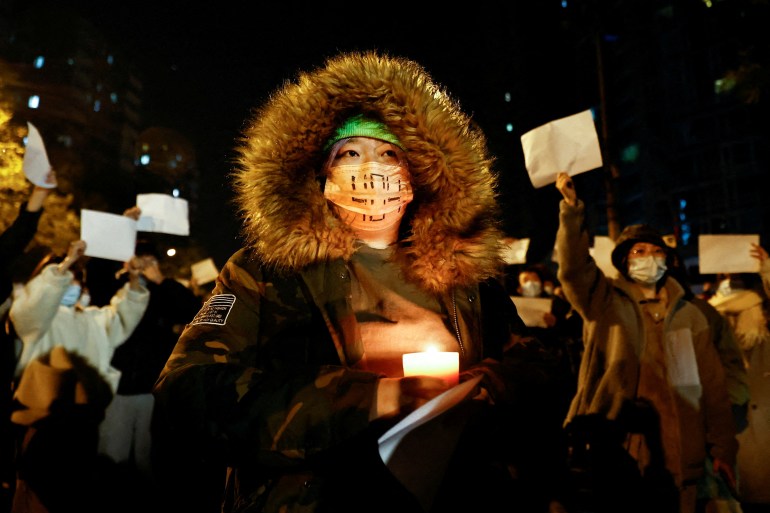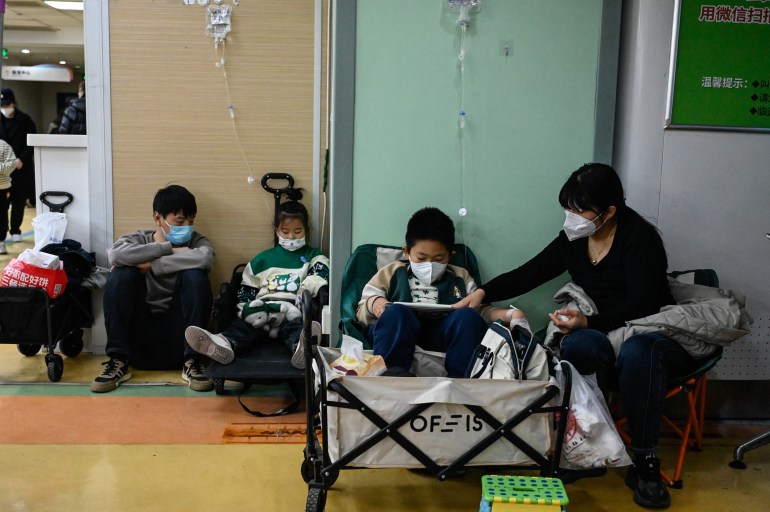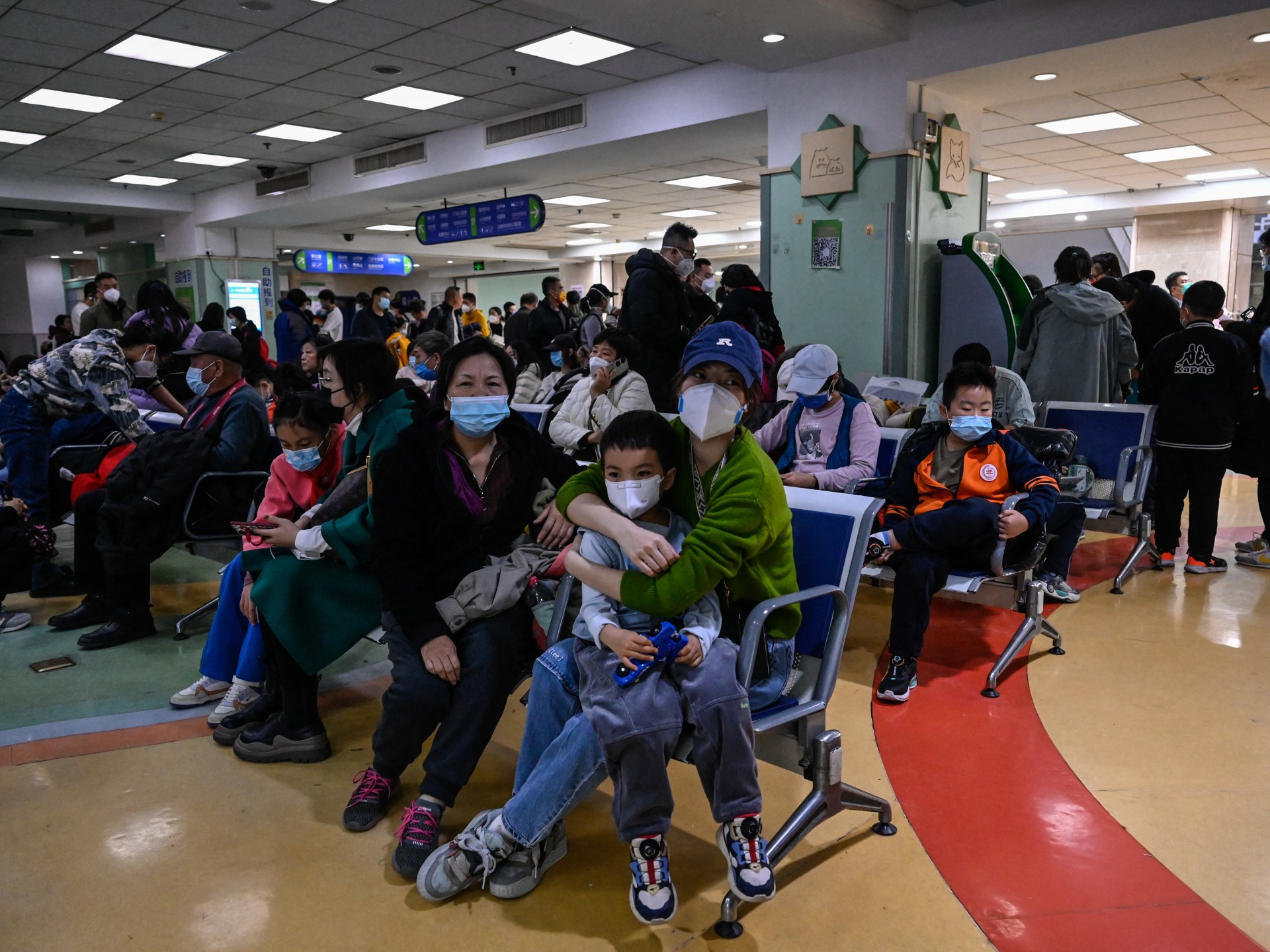When Evelyn Ma’s two-year-old daughter had a persistently high fever and a bad cough earlier this month, she and her husband began to worry.
The couple decided to take their daughter to a nearby children’s hospital in the city of Jinan.
But as Ma walked through the doors with her daughter in her arms, she found a scene of chaos.
“Doctors and nurses were rushing around everywhere between long lines of patients waiting their turn, and people were even sitting on the floor and against the walls,” Ma, who is 36 and works as a sales representative in China’s northeastern Shandong province, told Al Jazeera.
China experienced a sharp rise in cases of influenza, pneumonia, RSV and common cold viruses, particularly among children, in early October. By the next month, the surge in the number of people seeking medical attention had put a strain on hospitals, especially those catering to children.
“We arrived at the hospital in the early morning, but we didn’t get to see a doctor until the late afternoon, and I think that was only because my daughter’s symptoms were quite bad and my husband and I made a fuss,” Ma said.
The rising infections and reports of undiagnosed pneumonia sparked concern that the world was on the cusp of another novel pandemic outbreak spreading from China, after COVID-19 also first appeared as undiagnosed pneumonia in the central city of Wuhan.
But after requesting data from China, the World Health Organization (WHO) concluded there was no cause for alarm because the evidence suggested there was no new pathogen.
The jump in cases, it appears, was more a reflection of the return of illnesses that had been suppressed by the country’s prolonged pandemic lockdowns.
Ma’s daughter soon recovered, but the experience brought back upsetting memories.
“Last time I was at the hospital was in late December last year, and I was also sitting in a crowded waiting room filled with coughing people,” she said.
“Back then I was holding the hand of my grandmother who was very sick with COVID,” Ma said.

Just a few weeks before that, the Chinese authorities had abandoned the strict COVID measures that were a pillar of the country’s so-called zero-COVID policy after protests in several Chinese cities against the continued enforcement of lockdowns.
For three years until then, the zero-COVID policy had defined – and limited – Chinese people’s interactions with each other and the outside world in the name of combatting the pandemic.
“So many people suffered under the zero-COVID policy, and so many people died when it ended,” Ma said.
“Because of that, my family and I are traumatised to this day.”
Mental health struggles
Ma’s grandmother succumbed to COVID-19 in early January.
At about the same time, 29-year-old translator Lily Wang from Shenzhen also lost her grandmother to the virus.
She blames the authorities’ abrupt decision to abandon the zero-COVID policy for her death.
“If they had just given us a warning or given us time to prepare, we might have been able to save her,” Wang told Al Jazeera.
A wave of infections swept across China after the sudden end of the policy posing a particular hazard to elderly Chinese of whom only 40 percent had received a booster shot by December 2022. In the months that followed, upwards of almost two million more people died compared with the same period in previous years, according to a study by Hong Xiao and Joseph Unger of the Public Health Sciences Division at Seattle’s Fred Hutchinson Cancer Center that was published in August.
While the death of Wang’s grandmother was traumatic for her whole family, the strict lockdowns of China’s cities, which became a recurring phenomenon throughout 2022, were traumatic for Wang personally.
Her neighbourhood in the southern city of Shenzhen was repeatedly placed under total lockdown for months on end to quell flare-ups of COVID infections.
“We were not allowed to go outside – not even to stretch our legs, do grocery shopping or take out the garbage,” she said.

Wang was living alone in a small apartment at the time, and food supplies, provided by the authorities, were often late to arrive at her building.
“I was hungry, lonely and trapped, and I started to suffer from panic attacks,” she added.
As soon as the COVID policy ended, she moved out of the apartment and back home with her parents.
“After zero-COVID, I just couldn’t stay in the apartment any more,” she said.
“Even today, it is still difficult for me to be alone for more than a few days.”
Ma from Jinan has also struggled to recover mentally.
“I am much more concerned about the future than I was before 2022,” she said.
During the lockdown of her family’s neighbourhood, they also experienced food supplies arriving late.
“Now I get nervous when we don’t have much food left in the apartment, so I make sure that we have lots of meals available in the freezer and the refrigerator in case something happens,” she explained.
Hou Feng, a 31-year-old programmer from Shanghai, has also had trouble sleeping since the strict lockdown of Shanghai that took place from April until June 2022.
“During that time, people in my building contacted the authorities to accuse each other of breaking the COVID rules,” Hou told Al Jazeera.
Residents of Shanghai, China’s biggest city, were required to undergo constant COVID-19 testing, and it was obligatory to report to one of the city’s quarantine centres if the result was positive.
Hou witnessed his screaming neighbour getting dragged out of her home by the authorities when she refused to leave of her own volition after testing positive.
He still has nightmares about people in white hazmat suits breaking down his door and taking him away to a quarantine facility.
“I just saw some really bad sides of China during the lockdown that I never thought I would see.”
Loud success, quiet failure
While the zero-COVID policy ended in failure and trauma, according to Hou, it was initially quite successful.
“In 2020 and 2021, we luckily didn’t really feel the pandemic in China,” he said.
After a late response to the initial COVID-19 outbreak in Wuhan, the Chinese authorities subsequently managed to get the pandemic under control, and by mid-2020, normal life had resumed and social order was restored.
That was a contrast to several high-income countries in the Western world where health services struggled when the pandemic first struck, according to assistant professor Yan Long, who has studied the development of Chinese public health policies at the University of California, Berkeley.
That also made the zero-COVID policy a source of national pride in China and an opportunity for the Chinese leadership to showcase, at least domestically, that China had outdone countries such as the United States.
“It was a way to say, ‘Look, democracy has failed, we succeeded’,” Long told Al Jazeera.
The success began to fray, however, with the emergence of more infectious COVID-19 variants such as omicron. Immense resources were poured into constant rounds of mass testing and the implementation of lockdowns, but the measures failed to put an end to new outbreaks.
“The zero-COVID policy became financially unsustainable, and scientifically impossible, while the confidence in the policy also began to drastically decline,” Long said.
“By 2022, COVID was no longer the biggest fear. People were more afraid of the disruption of the lockdowns.”

Hou from Shanghai agrees that towards the end, the zero-COVID policy felt worse than COVID-19.
“The policy made life a living hell,” he said.
Hou knows of many people who experienced traumatic episodes during the lockdowns as well as in the subsequent rapid reopening of society.
“But unlike me, most people I know don’t want to talk about the COVID times. They just want to forget them,” he said.
Long, the academic, doubts that Chinese people have had a chance to heal after what happened.
“It is now a year later, and there has been no discussion about COVID, no reflection about what was right and what was wrong,” she said.
“When you bury the memory, you don’t learn any lessons, which means there is no guarantee that the same mistakes won’t be made again.”
Sumber: www.aljazeera.com
 Skip to content
Skip to content

